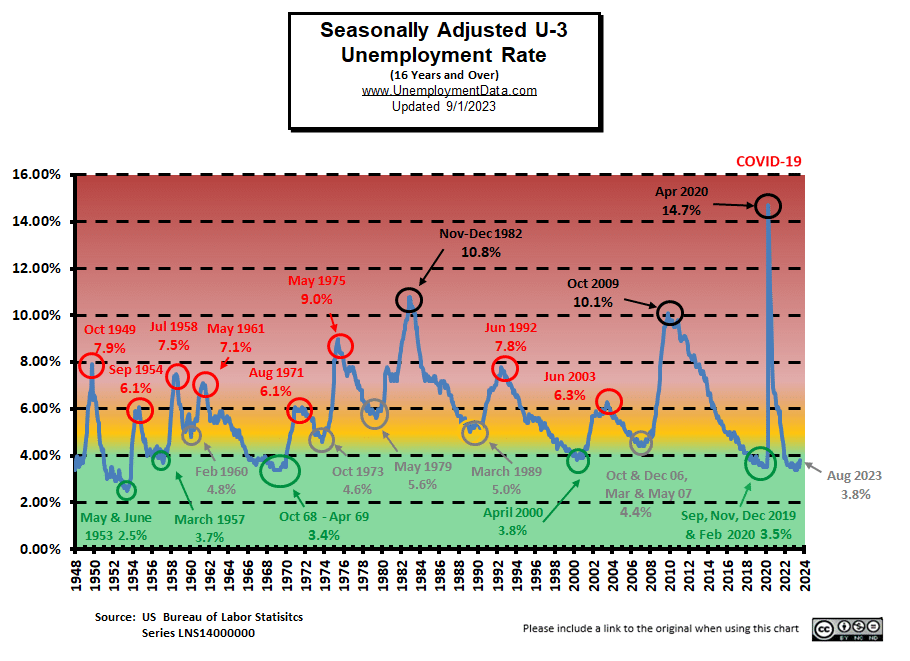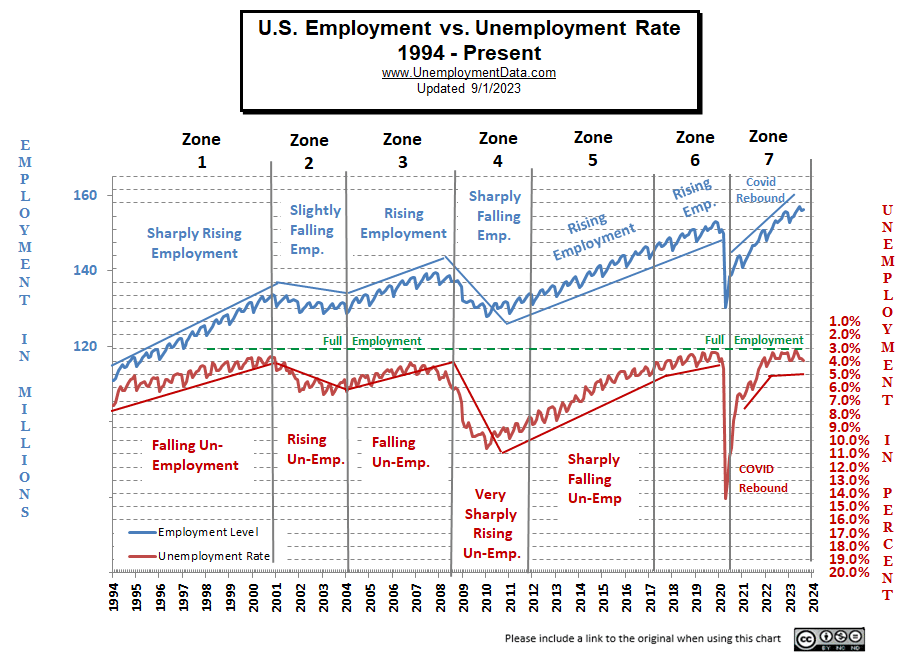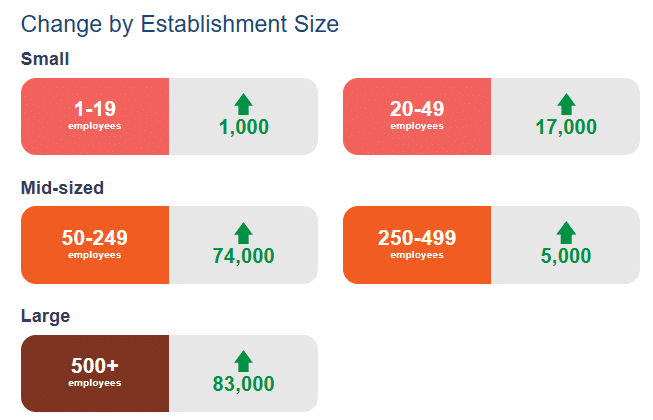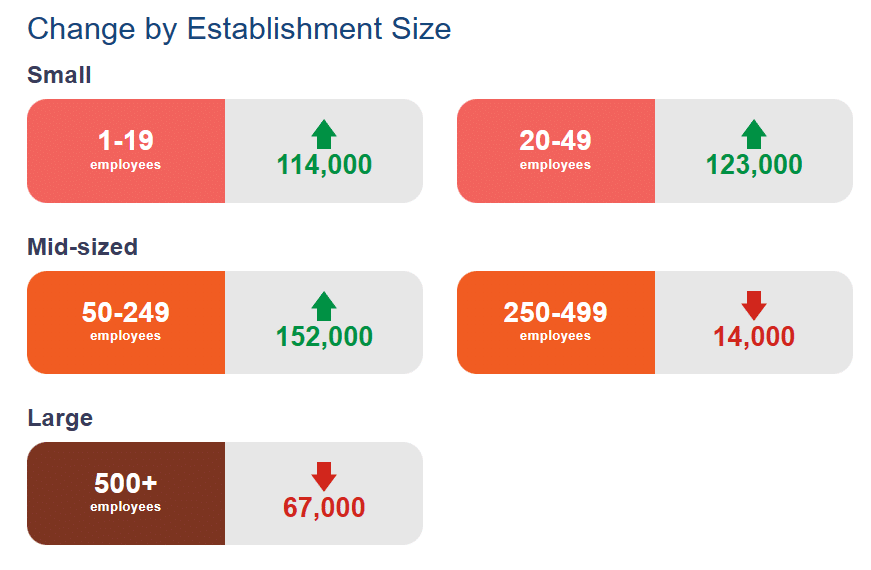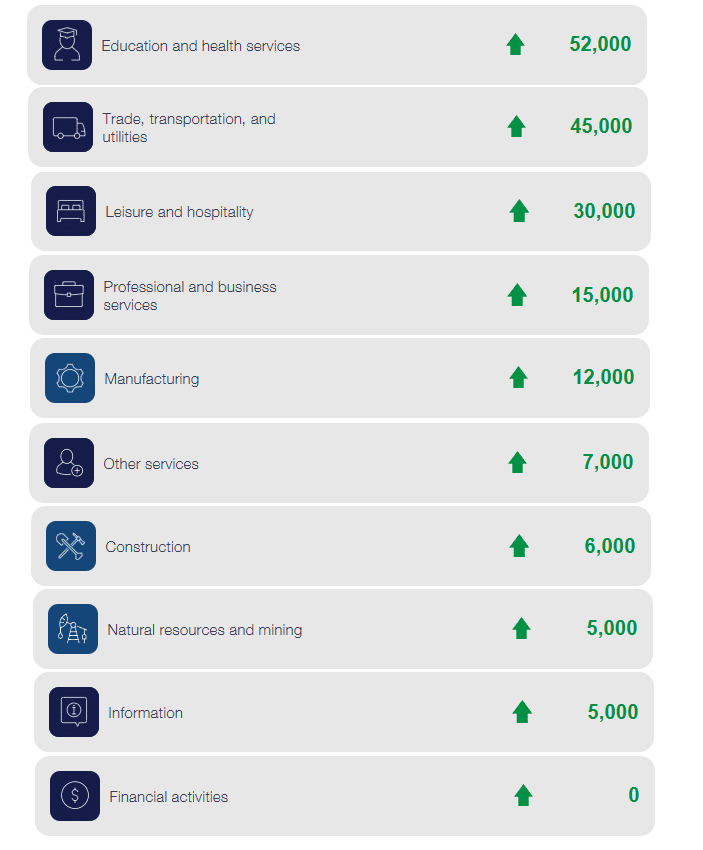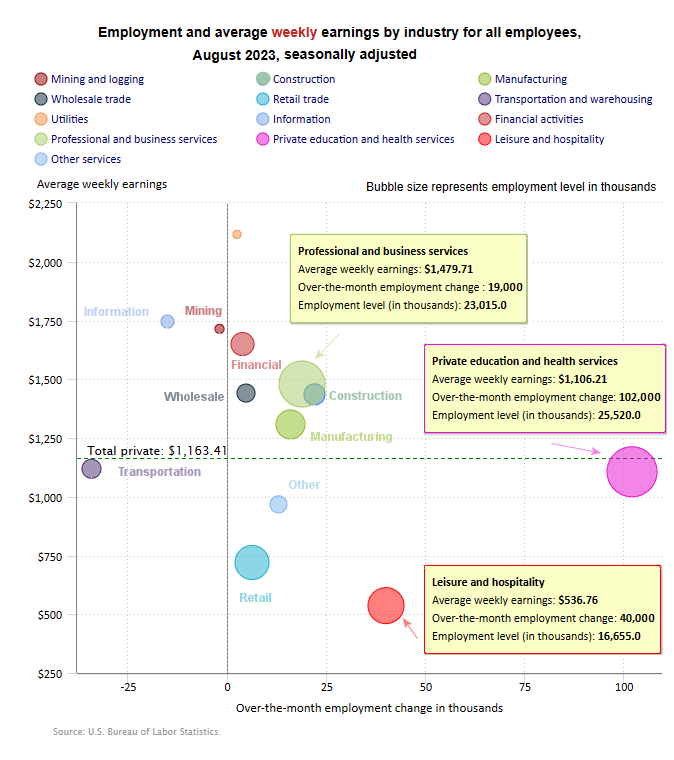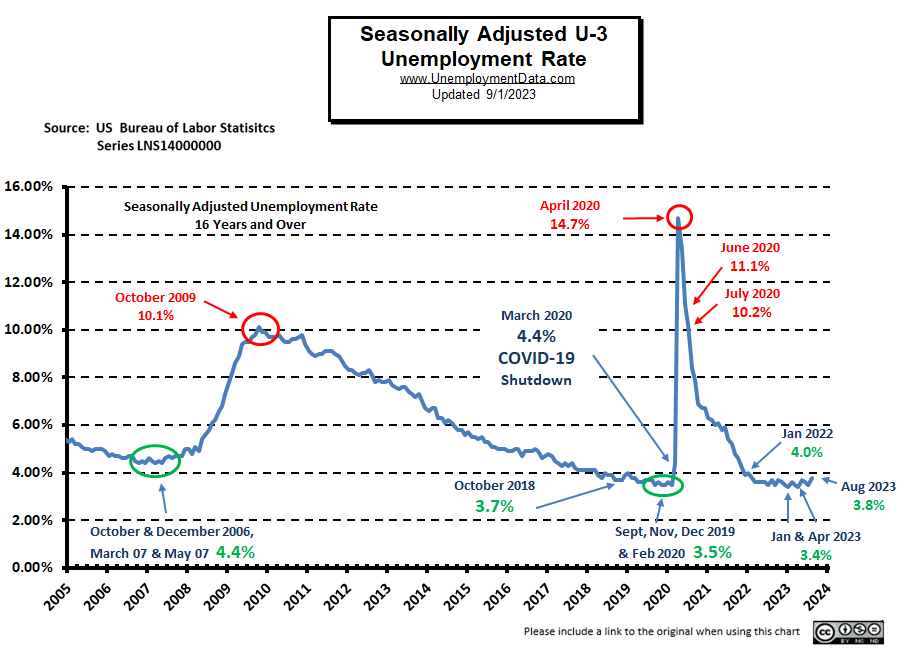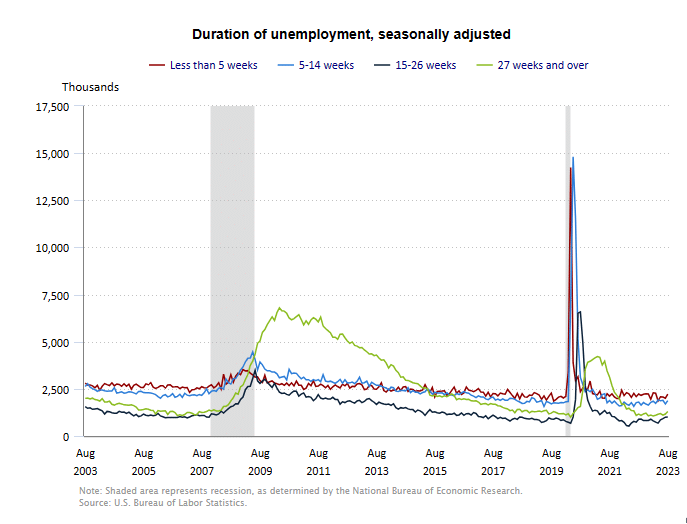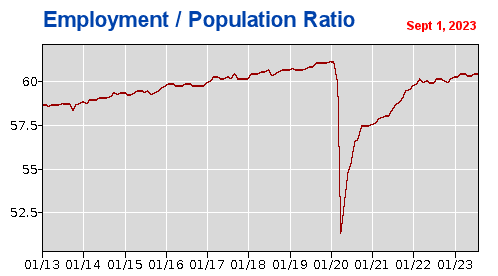The U.S. Bureau of Labor Statistics (BLS) released its employment / unemployment report for August on September 1st 2023.
August Unemployment Up Slightly
![]()
- Adjusted U-3 was 3.8% up from 3.5%
- Unadjusted U-3 was 3.9% up from 3.8%
- Unadjusted U-6 was 7.2% up from 7.1%
- Labor Force Participation was 62.8% up from 62.6%
- Unadjusted Employment rose from 156.034 to 156.302 million
Summary:
Despite the fact that the adjusted U3 unemployment rate was up,
slightly more people were working in August than in July.
Total Employed went up from 156.034 million in July to 156.302 million in August.
According to the Commissioner of the U.S. Bureau of Labor Statistics:
“Total nonfarm payroll employment increased by 187,000 in August, and the unemployment rate rose to 3.8 percent, the U.S. Bureau of Labor Statistics reported today. Employment continued to trend up in health care, leisure and hospitality, social assistance, and construction. Employment in transportation and warehousing declined.”
You can read the full BLS report here.
As usual, they are talking about “Seasonally Adjusted Jobs”.
Looking at the Unadjusted Establishment Survey report we see…
Originally the BLS reported employment of 155.126 million for July which they adjusted to 156.034 million. So they subtracted 92,000 jobs for July. They are currently reporting 156.302 million jobs for August which is actually an increase of 176,000 jobs based on their original estimates or an increase of 268,000 based on their updated numbers.
BLS Source
Current Employment Rate Chart
Adjusted Unemployment is slightly above the pre-COVID 2019 cyclical lows of 3.5%. Current levels are still within the “Green Zone”.
Leaving Full Employment?
This chart compares employment levels with the (inverted) unemployment rate.
Full Employment is when everyone who wants a job has one. It is generally considered to be around 3%. After the unemployment rate almost touched the magic full employment line in April, it began moving away (i.e., higher unemployment). If this continues into the fall months, it could be the beginning of a recession.
Note: The Unemployment rate is inverted to track the employment rate. Neither is Seasonally Adjusted. For more information see Employment vs. Unemployment.
Full employment is not considered to be at zero percent because even when employers are having difficulty finding employees, some people are still unemployed due to either structural unemployment (mismatch between worker skills and job requirements, i.e., not enough training) or simply because they quit their job knowing it would be easy to find another (hopefully better) job. Often referred to as frictional unemployment (there will always be people who have quit or have lost a seasonal job and are in the process of getting a new job). See: Highly Skilled Worker Shortage in a Recession?
If the unemployment rate stays constant, but more people are working, where are these extra workers coming from?
Somehow the workforce has to be growing to accommodate these newly created jobs. They could be long-term unemployed (no longer counted in the workforce) returning to the workforce, they could be immigrants entering the workforce, or possibly retired people coming out of retirement because of an offer too good to turn down. This is generally facilitated by rising wages, but this month’s ADP report indicates that wage growth has slowed, possibly indicating that we are nearing the end of this boom.
Current Employment Rate
Employment 3.251 million Above Year-Ago Levels
and 5.158 million above February 2020 (prior to the Covid Crash)
But the Civilian Population has increased by about 7.374 million since February 2020.
August employment was up slightly for the month, at 156.302 million, still above the November 2022 peak employment level of 155.642 million. In January 2023, we had the typical drop taking employment slightly below the 2019 peak of 153.095 million.
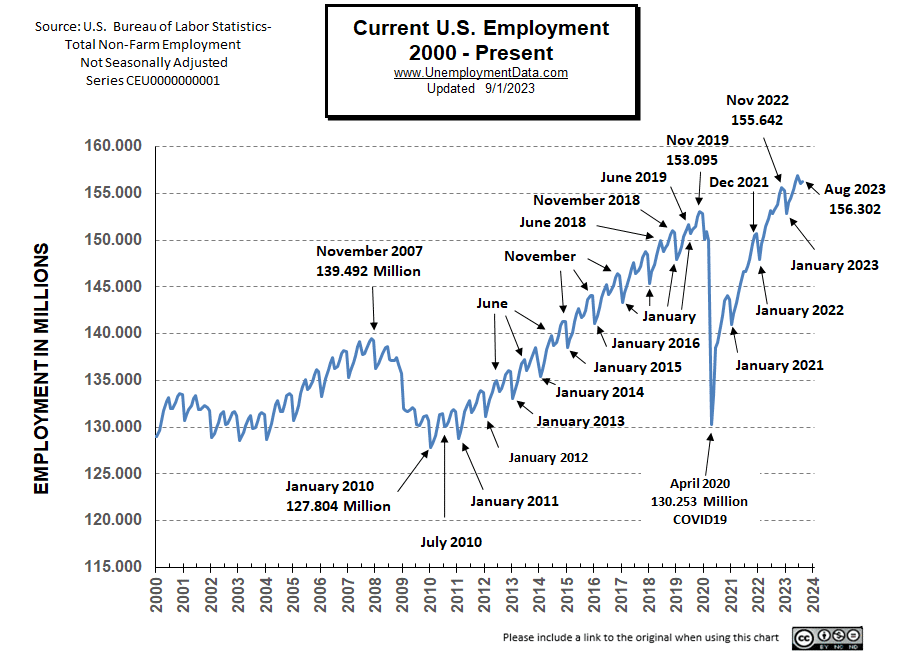
ADP® National Employment Report
ADP provides an independent (non-government) estimate of private-sector employment and pay, based on data derived from ADP client payrolls. According to ADP®, In collaboration with Stanford Digital Economy Lab.
ADP: Private employers added 177,000 jobs in August
- Job growth slowed notably last month, driven heavily by leisure and hospitality. Job creation by hotels, restaurants and other employers in the sector fell to 30,000 in August after months of strong hiring.
Nela is now saying pretty much what I’ve been saying for a few months now, i.e., that the slope of the current light green arrow is roughly the same as the rate of increase in jobs from 2011 through mid-2018.
From Mid-2018 through 2020, the rate of increase dropped off as the economy reached “full employment” and then total employment slightly decreased (Yellow arrow). The red arrow is the COVID crash in employment. Then the dark green arrow shows the rapid recovery of jobs. By Mid-2022, employment was back at pre-COVID levels. So, we can see that since mid-2022, employment has been on the same trajectory as it was from 2011 to 2018, with perhaps even a slight upturn in June/July.
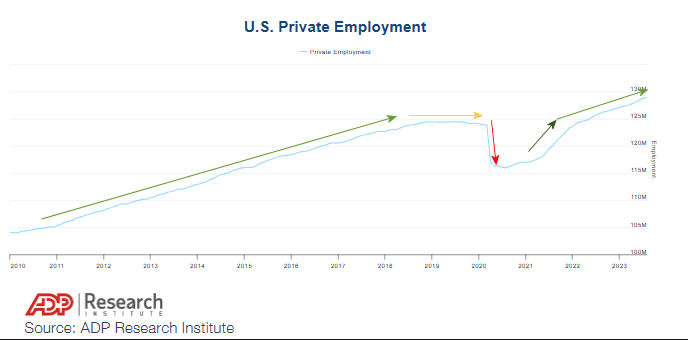
ADP Private Employment by Firm Size
ADP also lists increases by “firm size”.
This month, all size companies showed gains.
August ADP Changes:
Although all segments are positive the totals are lower than in July.
July ADP Changes:
ADP Job Gainers
According to ADP, all sectors gained employees in August except Financial.
BLS: August 2023 Employment by Sector
The BLS employment “bubble chart” gives us a slightly different picture than the ADP does. The Bubble’s Size tells us the total Employment for that industry (i.e., larger bubbles mean more people are employed in that sector).
The bubble’s location on the chart tells us that there has been a change in Employment Levels over the most recent month… A bubble further to the right indicates larger job growth. A bubble’s vertical location on the chart shows the average industry salary.
Remember, these are Seasonally Adjusted Numbers, so they aren’t cumulative!
According to ADP, Education & Health, gained 52,000 jobs but the BLS says it gained 102,000 seasonally adjusted jobs.
BLS Average Weekly Wages
| Date | Average Weekly Wage |
| August 2023 | $1,163.41 |
| July 2023 | $1,157.28 |
| June 2023 | $1,155.15 |
| May 2023 | $1,146.99 |
| April 2023 | $1,147.58 |
| March 2023 | $1,141.34 |
| February 2023 | $1,141.61 |
| January 2023 | $1,146.14 |
| December 2022 | $1,125.73 |
| November 2022 | $1,129.01 |
| October 2022 | $1,124.01 |
| September 2022 | $1,119.87 |
| August 2022 | $1,116.42 |
| July 2022 | $1,116.54 |
| June 2022 | $1,106.76 |
| May 2022 | $1,105.47 |
| April 2022 | $1,102.01 |
| December 2021 | $1,086.46 |
BLS Employment and Average Weekly Earnings by Industry
August 2023, Seasonally Adjusted Employment
We’ve added a column to the table below showing the employment levels the BLS reported the previous month. Note that due to “seasonal adjusting,” although they may claim that there was a “monthly increase” (or decrease), there isn’t always an actual increase; you can’t just subtract last month’s “employment level” from this month’s level. For instance, Mining was supposed to have 643,000 employees in July and have a -2,000 decrease, but in August, there were 642,000 employed. That looks like a -1,000 decrease, to me. And Wholesale went from 6,063,800 July to 6,070,100 in August for a seasonally adjusted 4,700 increase, but it seems like an 6,300 increase to me.
| Industry | August Monthly Increase | Aug. Ave. Weekly Earnings | Aug. Employment Level | July Employment Level |
| Total Private Employment | 179,000 | $1,163.41 | 133,761,000 | 133,641,000 |
| Mining and Logging | -2,000 | $1,714.61 | 642,000 | 643,000 |
| Construction | 22,000 | $1,435.36 | 7,993,000 | 7,971,000 |
| Manufacturing | 16,000 | $1,307.66 | 12,997,000 | 12,985,000 |
| Wholesale trade | 4,700 | $1,441.25 | 6,070,100 | 6,063,800 |
| Retail trade | 6,300 | $720.30 | 15,544,900 | 15,542,500 |
| Transportation and Warehousing | -34,200 | $1,119.00 | 6,675,300 | 6,721,500 |
| Utilities | 2,500 | $2,116.27 | 557,300 | 557,100 |
| Information | -15,000 | $1,745.20 | 3,051,000 | 3,074,000 |
| Financial Activities | 4,000 | $1,649.71 | 9,158,000 | 9,163,000 |
| Professional and Business Services | 19,000 | $1,479.71 | 23,015,000 | 23,032,000 |
| Private Education and Health Services | 102,000 | $1,106.21 | 25,520,000 | 25,408,000 |
| Leisure and Hospitality | 40,000 | $536.76 | 16,655,000 | 16,593,000 |
| Other Services | 13,000 | $967.71 | 5,882,000 | 5,887,000 |
Source: BLS
Note: As usual, ADP presents an entirely different picture. See Above.
Unemployment
August’s Seasonally Adjusted Unemployment is 3.8%, up from 3.5% in July.
 August 2023 Labor Force Participation Rate
August 2023 Labor Force Participation Rate
The LFPR is up, at 62.8% from 62.6% in March-July.
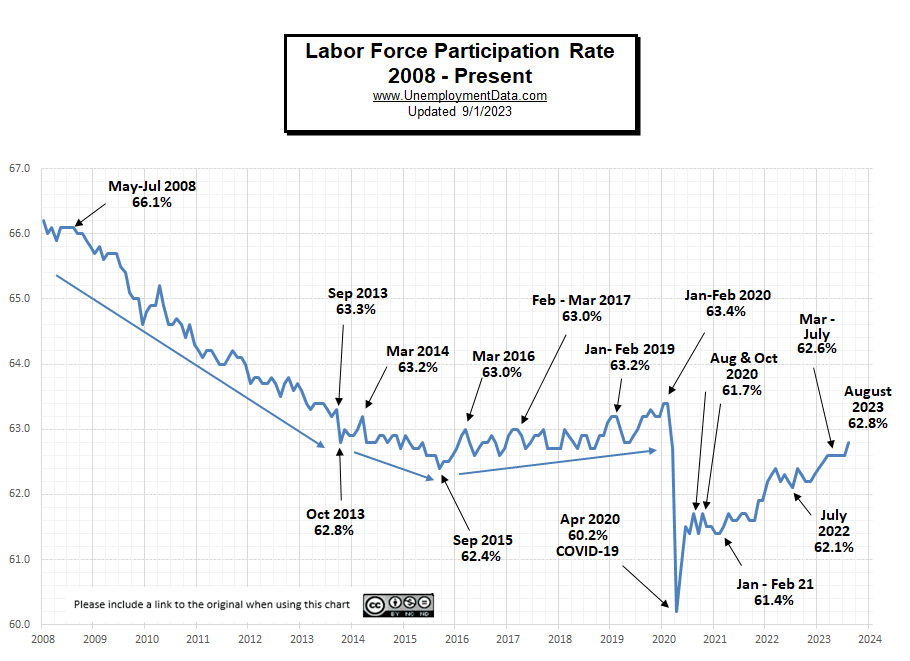
Seasonally Adjusted U1 through U6 Unemployment Rates
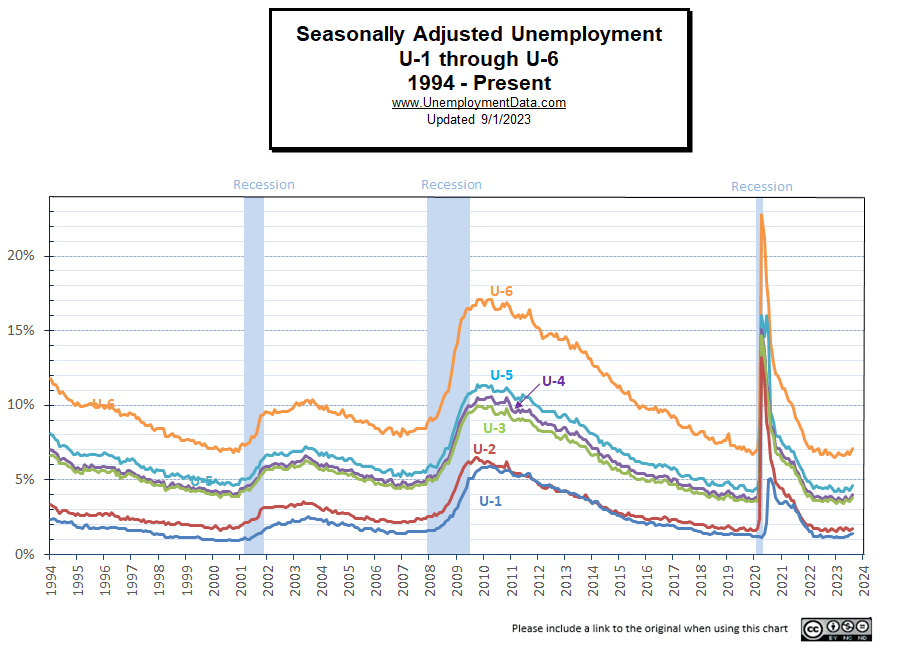
Seasonally Adjusted Unemployment by Education
For three months in a row, unemployment by the uneducated rose but in July it fell sharply. It rose again in August but not to previous levels.
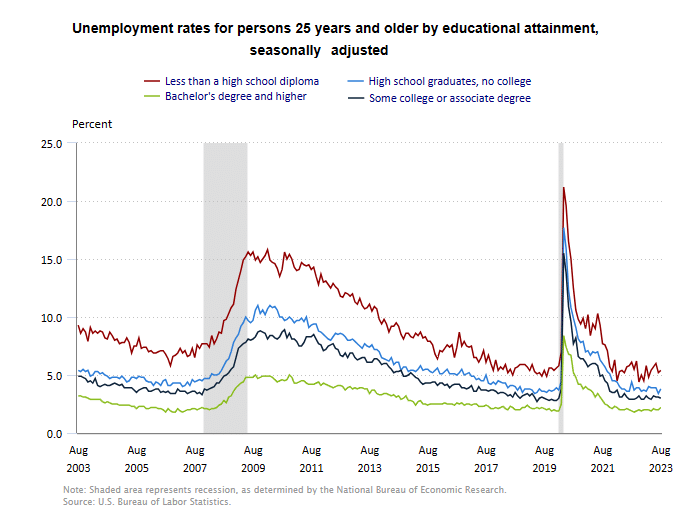
Duration of Unemployment
15-26 week unemployment ticked up again this month along with Long-term unemployment (over 27 weeks).
Employment-Population Ratio
The Employment / Population ratio fell from April’s 60.4% of the population employed to 60.3% in May and June. In July & August, it was 60.4%.
See Employment Population Ratio for more information.
Read more on UnemploymentData.com.
- Small Business Bookkeeping Solutions
- Different Kinds of Self-Employment That Don’t Require Running a Business
- Skills and Certifications You Need To Become a Plumber
- Things to Look for When Locating Your Business
From InflationData.com
- Inflation Is a Huge Wealth Redistribution Scheme
- When Can We Expect Lower FED Rates?
- July Annual Inflation- Up Slightly
- Do Private Corporations Cause Inflation?
- No Surprise… FED Raised Rate by 1/4%
- How Inflation Impacts Merchants
- What is the Difference between the CPI-U and the CPI-W
From Financial Trend Forecaster
- Moore Inflation Predictor
- NYSE ROC
- NASDAQ ROC
- The European Energy Crisis May Be Back Soon
- What Made Maui’s Lahaina Fire So Deadly?
- Which is Worse- Easy Money or Public Debt?
- Deepest Yield Curve Inversion Since 1981
- Is this the End of Fractional Reserve Banking?
- A Guide to Good Money
- Quick Takes on Big Financial Trends
- Extremely Rare Market Signal Just Triggered
- Stocks and Junk Bonds: “This Divergence Appears Meaningful”
From OptioMoney.com
- What Happens to Old Solar Panels?
- The Art of DIY: Saving Money by Learning New Skills
- Smart Ways to Save Money on Everyday Expenses
- Simple Ways to Improve Your Relationship with Money
- Smart Ways to Avoid Financial FOMO
- How Buying a House Affects Your Finances
From Your Family Finances

